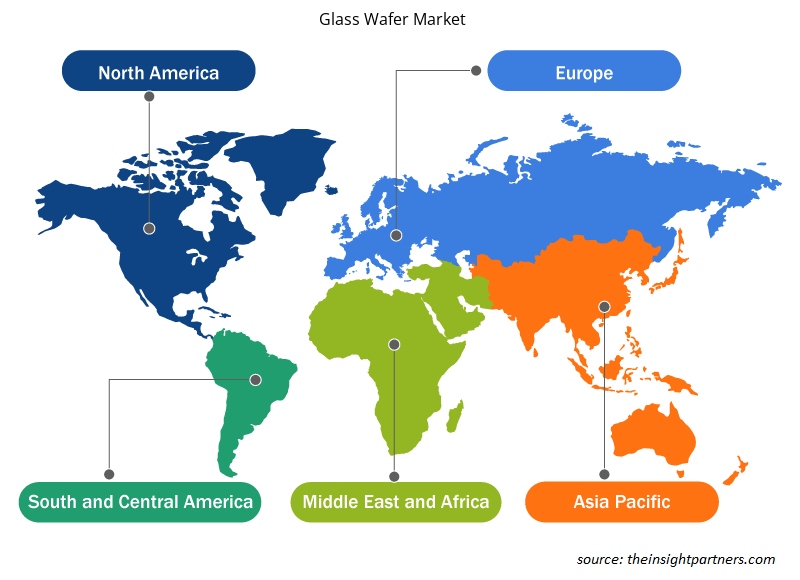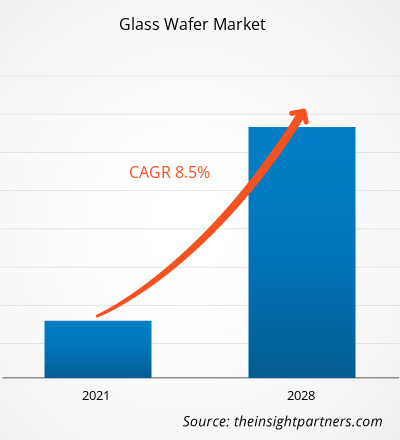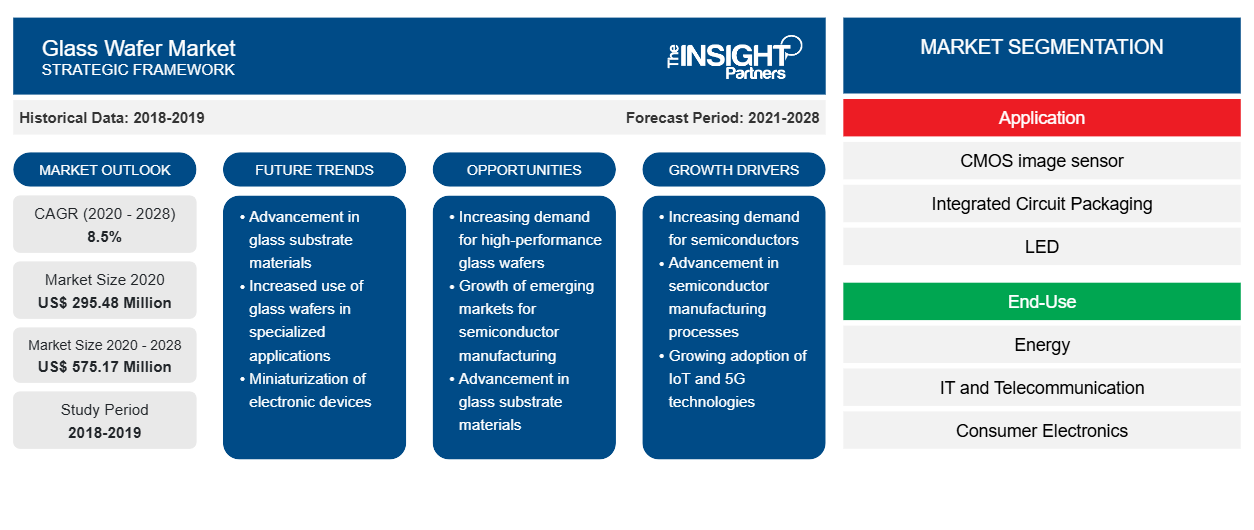Nel 2020 il mercato dei wafer di vetro era valutato 295,48 milioni di dollari USA e si prevede che raggiungerà i 575,17 milioni di dollari USA entro il 2028; si prevede una crescita a un CAGR dell'8,5% dal 2020 al 2028.
Un wafer di vetro è un disco sottile che viene utilizzato come base per la produzione di circuiti integrati e per la protezione nell'elettronica di consumo. Il wafer di vetro è solitamente costituito da quarzo, vetro borosilicato o silice fusa. Questi wafer sono utilizzati in un'ampia varietà di applicazioni industriali e tecniche. I wafer di vetro borosilicato offrono una maggiore stabilità chimica contro l'acqua o qualsiasi altro tipo di sostanza chimica. L'aumento della domanda di dispositivi elettronici di consumo compatti e avanzati guiderà la crescita del mercato dei wafer di vetro. L'aumento della domanda di elettronica per autoveicoli a causa dei veicoli elettrici e ibridi porterà a un aumento della domanda di wafer di vetro.
Nel 2020, l'Asia Pacifica ha contribuito alla quota maggiore del mercato globale dei wafer di vetro. Il predominio di questa regione è attribuito principalmente alla rapida crescita dell'industria automobilistica ed elettronica nella regione. La crescita esponenziale del settore industriale, tra cui automobilistico, medico e altri, ha influenzato la domanda di wafer di vetro. L'Asia è una delle principali regioni manifatturiere di componenti elettrici ed elettronici.
L'epidemia di COVID-19 è stata segnalata per la prima volta a Wuhan (Cina) nel dicembre 2020. A gennaio 2021, Stati Uniti, India, Brasile, Russia, Francia, Regno Unito, Turchia, Italia e Spagna sono tra i paesi più colpiti in termini di casi confermati e decessi segnalati. Secondo le ultime cifre dell'OMS aggiornate a gennaio 2021, ci sono circa 83.322.449 casi confermati e 1.831.412 decessi totali a livello globale. L'epidemia sta influenzando negativamente le economie e le industrie in vari paesi a causa di blocchi, divieti di viaggio e chiusure aziendali. L'industria globale di prodotti chimici e materiali è una delle principali industrie che subisce gravi interruzioni come interruzioni della catena di fornitura, cancellazioni di eventi tecnologici e chiusure di uffici. Sebbene la Cina sia il polo manifatturiero globale e il più grande fornitore di materie prime per vari settori, è anche uno dei paesi più colpiti. Il blocco di vari impianti e fabbriche in Cina sta limitando le catene di fornitura globali e interrompendo le attività di produzione, i programmi di consegna e varie vendite di prodotti chimici e materiali. Diverse aziende hanno già annunciato possibili ritardi nelle consegne dei prodotti e un crollo delle vendite future dei loro prodotti. Inoltre, i divieti di viaggio globali imposti dai paesi in Europa, Asia e Nord America stanno ostacolando le collaborazioni commerciali e le opportunità di partnership. Tutti questi fattori stanno ostacolando l'industria chimica e dei materiali, limitando così la crescita di vari mercati correlati a questo settore.
Personalizza questo report in base alle tue esigenze
Riceverai la personalizzazione gratuita di qualsiasi report, comprese parti di questo report, o analisi a livello nazionale, pacchetto dati Excel, oltre a usufruire di grandi offerte e sconti per start-up e università
-
Scopri le principali tendenze di mercato in questo rapporto.Questo campione GRATUITO includerà analisi di dati che spaziano dalle tendenze di mercato alle stime e alle previsioni.
Approfondimenti di mercato
Crescente domanda di MEM
C'è un aumento della domanda di sistemi microelettromeccanici (MEMS) in tutto il mondo, a causa delle loro applicazioni nei sistemi di comunicazione, nei sensori automobilistici e nei dispositivi medici portatili. Il design in miniatura di questi MEM li rende adatti all'uso in tutti i dispositivi elettronici, il che ha aumentato l'applicazione dei MEM. I wafer di vetro sono usati principalmente nel confezionamento di wafer di componenti sensibili, a causa della loro funzionalità superiore, affidabilità e capacità di resistere ad ambienti difficili. Questi wafer di vetro sono anche usati come substrati di supporto grazie alla loro resistenza chimica e stabilità termica. La domanda di apparecchiature mediche portatili, che includono dispositivi di monitoraggio dei pazienti, è aumentata durante la pandemia, a causa del maggiore utilizzo e della domanda da parte degli operatori sanitari in tutto il mondo. La pandemia di COVID-19 ha aumentato la domanda di dispositivi di monitoraggio personale tra i consumatori. Questi dispositivi sono integrati con i MEMS. Quindi, c'è un aumento della domanda di MEM, che a sua volta sta spingendo la crescita del mercato dei wafer di vetro.Micro-Electro-Mechanical Systems (MEMS) across the world, owing to their applications in communication systems, automotive sensors, as well as portable medical devices. The miniature design of these MEMs makes them a suitable for use in all electronic devices, which has increased the application of MEMs. Glass wafers are mostly used in wafer packaging of sensitive components, owing to their superior functionality, reliability, and capacity to withstand harsh environments. These glass wafers are also used as carrier substrates due to their chemical resistance and thermal stability. The demand for portable medical equipment, which includes patient monitoring devices, has been on the rise during the pandemic, owing to the increased usage and demand by health workers across the world. The COVID-19 pandemic has boosted the demand for personal monitoring devices among the consumers. These devices are integrated with MEMS. Hence, there is an increase in demand for MEMs, which in turn is propelling the growth of the glass wafers market.
Approfondimenti sulle applicazioni
In base all'applicazione, il mercato dei wafer di vetro è segmentato in sensore di immagine CMOS, confezionamento di circuiti integrati (IC), LED, microfluidica, FO-WLP e mems e RF. Il segmento dei sensori di immagine CMOS ha guidato il mercato con la quota maggiore nel 2020. Un sensore di immagine o imager è un sensore che rileva e trasmette informazioni, che vengono utilizzate per creare un'immagine. Esistono due tipi di sensori di immagine elettronici: dispositivi ad accoppiamento di carica (CCD) e sensori a pixel attivi (sensore CMOS). Il sensore a pixel attivi è un sensore di immagine in cui ogni sensore a pixel ha un fotodiodo. Diversi tipi di sensori a pixel attivi includono il primo NMOS APS e quello comune che è il complementare MOS (CMOS) APS, noto come sensore CMOS ed è ampiamente utilizzato nelle tecnologie delle fotocamere digitali e nei cellulari. Il sensore di immagine CMOS ha varie proprietà come basso consumo energetico, elevata integrazione e velocità di lettura IO rapida, grazie alle quali è diventato uno dei sensori più ampiamente utilizzati.CMOS image sensor, integrated circuit (IC) packaging, LED, Microfluidics, FO-WLP, and mems and RF. The CMOS image sensor segment led the market with the largest share in 2020. An image sensor or imager is a sensor that detects and conveys information, which are used to make an image. There are two types of electronic image sensors that are charge-coupled device (CCD) and active-pixel sensor (CMOS sensor). Active pixel sensor is an image sensor in which every pixel sensor has a photodetector. Different types of active pixel sensor include the early NMOS APS and the common one that is the complementary MOS(CMOS) APS, which is known as the CMOS sensor, and is widely used in digital camera technologies as well as in cellphones. CMOS image sensor has various properties such as low power consumption, high integration, and fast IO readout speed due to which it has become one of the most widely used sensors.
Tra i principali attori del mercato dei wafer di vetro figurano SCHOTT AG; AGC Inc.; Corning Incorporated; Plan Optik AG; Shin-Etsu Chemical Co., Ltd; Samtec, Inc; Bullen; Nippon Electric Glass; Swift glass; e Coresix Precision Glass, Inc. I principali attori del mercato si stanno concentrando su strategie quali fusioni e acquisizioni e lanci di prodotti per espandere la presenza geografica e la base di consumatori a livello globale. SCHOTT AG; AGC Inc.; Corning Incorporated; Plan Optik AG; Shin-Etsu Chemical Co., Ltd; Samtec, Inc; Bullen; Nippon Electric Glass; Swift glass; and Coresix Precision Glass, Inc. Major players in the market are focusing on strategies such as mergers and acquisitions and product launches to expand the geographical presence and consumer base globally.
Approfondimenti regionali sul mercato dei wafer in vetro
Le tendenze regionali e i fattori che influenzano il Glass Wafer Market durante il periodo di previsione sono stati ampiamente spiegati dagli analisti di Insight Partners. Questa sezione discute anche i segmenti e la geografia del Glass Wafer Market in Nord America, Europa, Asia Pacifico, Medio Oriente e Africa e Sud e Centro America.

- Ottieni i dati specifici regionali per il mercato dei wafer di vetro
Ambito del rapporto sul mercato dei wafer di vetro
| Attributo del report | Dettagli |
|---|---|
| Dimensioni del mercato nel 2020 | 295,48 milioni di dollari USA |
| Dimensioni del mercato entro il 2028 | 575,17 milioni di dollari USA |
| CAGR globale (2020 - 2028) | 8,5% |
| Dati storici | 2018-2019 |
| Periodo di previsione | 2021-2028 |
| Segmenti coperti |
Per applicazione
|
| Regioni e Paesi coperti |
America del Nord
|
| Leader di mercato e profili aziendali chiave |
|
Densità degli attori del mercato dei wafer di vetro: comprendere il suo impatto sulle dinamiche aziendali
Il mercato del Glass Wafer Market sta crescendo rapidamente, spinto dalla crescente domanda degli utenti finali dovuta a fattori quali l'evoluzione delle preferenze dei consumatori, i progressi tecnologici e una maggiore consapevolezza dei vantaggi del prodotto. Con l'aumento della domanda, le aziende stanno ampliando le loro offerte, innovando per soddisfare le esigenze dei consumatori e capitalizzando sulle tendenze emergenti, il che alimenta ulteriormente la crescita del mercato.
La densità degli operatori di mercato si riferisce alla distribuzione di aziende o società che operano in un particolare mercato o settore. Indica quanti concorrenti (operatori di mercato) sono presenti in un dato spazio di mercato in relazione alle sue dimensioni o al valore di mercato totale.
Le principali aziende che operano nel mercato dei wafer di vetro sono:
- SCOTTINO
- Società anonima AGC Inc.
- Corning Incorporata
- Plan Optik AG
- Bullone
Disclaimer : le aziende elencate sopra non sono classificate secondo un ordine particolare.

- Ottieni una panoramica dei principali attori del mercato dei wafer di vetro
Segnala i riflettori
Tendenze industriali progressive a livello globale
- mercato delle cialde di vetro per aiutare i giocatori a sviluppare strategie efficaci a lungo termine
- Strategie di crescita aziendale adottate dai mercati sviluppati e in via di sviluppo
- Analisi quantitativa del mercato globale delle cialde di vetro dal 2017 al 2028
- Stima della domanda di wafer di vetro in vari settori industriali
- Analisi PEST per illustrare l'efficacia degli acquirenti e dei fornitori che operano nel settore per prevedere la crescita del mercato
- Sviluppi recenti per comprendere lo scenario competitivo del mercato e la domanda di wafer di vetro
- Tendenze e prospettive del mercato, insieme ai fattori che guidano e frenano la crescita del mercato dei wafer di vetro
- Processo decisionale attraverso la comprensione delle strategie che sostengono l'interesse commerciale in relazione alla crescita del mercato globale dei wafer di vetro
- Dimensioni del mercato delle cialde di vetro in vari nodi del mercato
- Panoramica dettagliata e segmentazione del mercato globale delle cialde di vetro nonché delle sue dinamiche nel settore
- Dimensioni del mercato delle cialde di vetro in varie regioni con promettenti opportunità di crescita
Mercato delle cialde di vetro, per applicazione
- Sensore di immagine CMOS
- Confezionamento di circuiti integrati (IC)
- GUIDATO
- Microfluidica
- FO-WLP
- MEMS e RF
- Altri
Mercato delle cialde di vetro, per uso finale
- Energia
- Informatica e telecomunicazioni
- Elettronica di consumo
- Aerospaziale e difesa
- Automobilistico
- Sanità e biotecnologia
- Altri
Profili aziendali
- SCHOTT AG
- Società anonima AGC Inc.
- Corning Incorporata
- Plan Optik AG
- Società chimica Shin-Etsu, Ltd.
- Italiano:
- Bullone
- Vetro elettrico Nippon
- Vetro veloce
- Vetro di precisione Coresix, Inc.
- Analisi storica (2 anni), anno base, previsione (7 anni) con CAGR
- Analisi PEST e SWOT
- Valore/volume delle dimensioni del mercato - Globale, Regionale, Nazionale
- Industria e panorama competitivo
- Set di dati Excel
Report recenti
Rapporti correlati
Testimonianze
Motivo dell'acquisto
- Processo decisionale informato
- Comprensione delle dinamiche di mercato
- Analisi competitiva
- Analisi dei clienti
- Previsioni di mercato
- Mitigazione del rischio
- Pianificazione strategica
- Giustificazione degli investimenti
- Identificazione dei mercati emergenti
- Miglioramento delle strategie di marketing
- Aumento dell'efficienza operativa
- Allineamento alle tendenze normative























 Ottieni un campione gratuito per - Mercato delle cialde di vetro
Ottieni un campione gratuito per - Mercato delle cialde di vetro